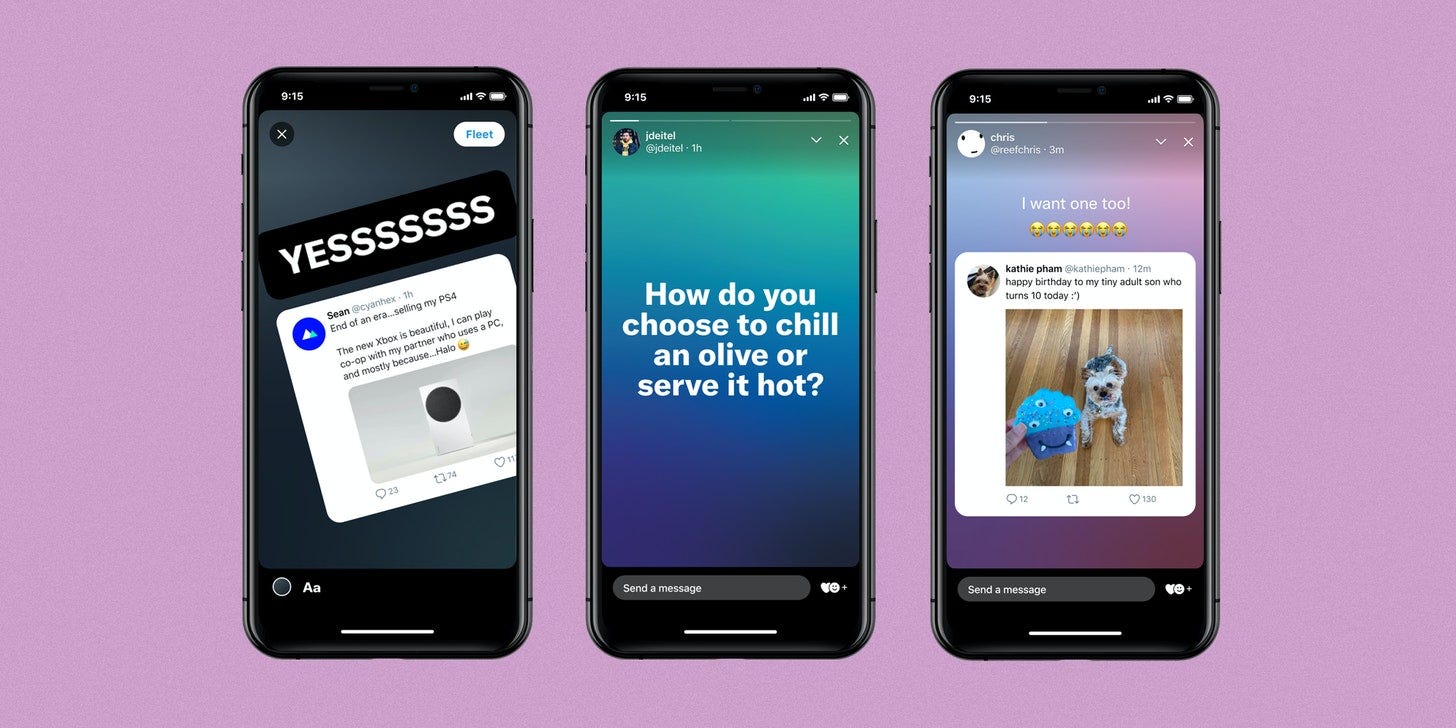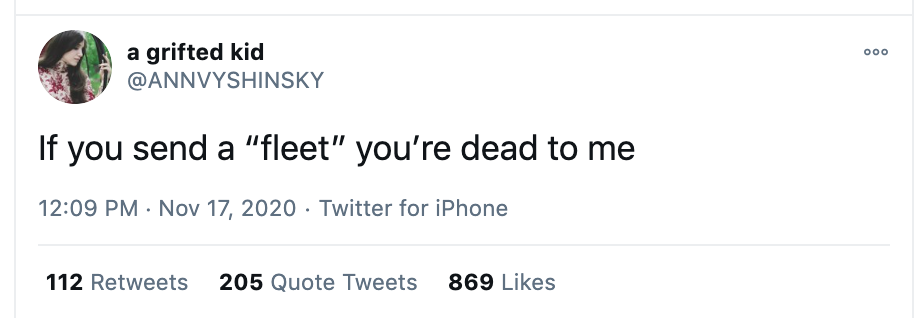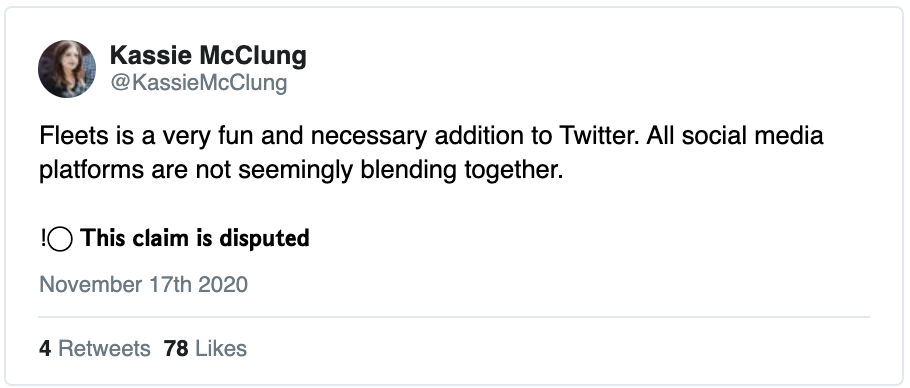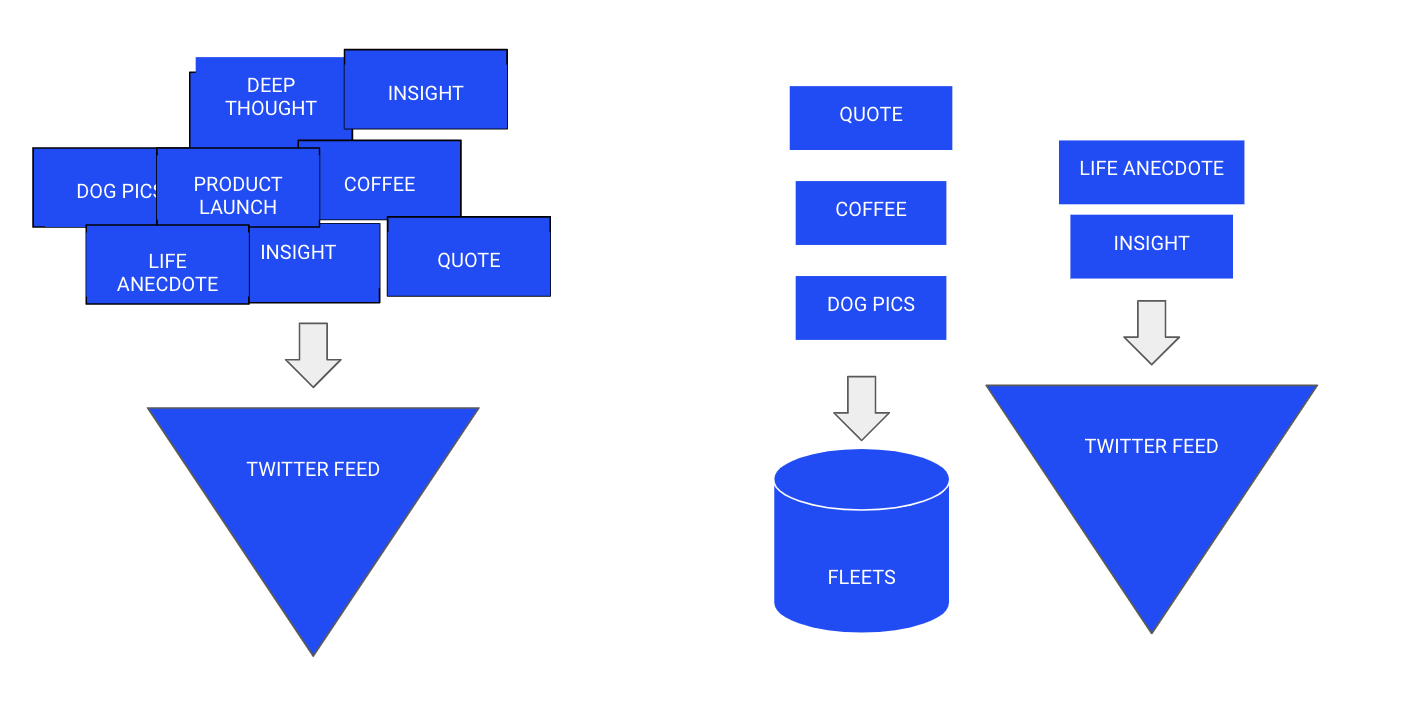✍️ This piece was originally published as part of my new Substack newsletter, the Marketing Mind Meld. Subscribe there for weekly marketing reads!
It’s been a long month for Twitter.
After scrambling to brainstorm misinformation labels and trying to survive amongst an entire subset of their users losing their sanity, the company decided to throw a bone this past week by releasing something new: a feature it calls Fleets.
What are Fleets? Fleets are effectively another version of the popular stories feature. The UI and core functions are familiar to most social media users — if you’ve used Facebook or Instagram, you’ve likely seen the row of circles at the top, all platform users sharing an image or video.
A small glimpse into our lives.


By nature, fleets are ephemeral, fleeting in your feed. Similar to Linkedin’s recent launch, Twitter doesn’t have the suite of effects Instagram or Facebook provides users for stories but they do have a tolerable starter product — texts, videos, and even a sharing feature that allows you post a tweet directly to your Fleets.
So how did Twitter users — the haven of bright minds, energetic creators, and optimistic technologists react to this new release from the company?




In short, not great.
Criticism continued throughout the day, even prompting a #FleetsFeedbackhashtag; many lamented the other Twitter features that have been requested over the years (i.e. edit buttons, sorting bookmarks, banning Nazis) and some just citing the lack of enthusiasm around Twitter essentially announcing a feature that existed on four other social networks. People who come to Twitter to get away from IG suddenly saw the value diluted in real-time.
Based simply on general reactions to the launch, it would be easy to dismiss Fleets as an early failure.
But when I wrote my piece a few weeks back on why we hate brand redesigns, it opened my eyes to an irrational pattern in human beings: how we tend to have very strong negative reactions to change that can sometimes dissipate in as little as a few days.
So I had to ask myself the question: Is Fleets here to stay for good?
In September, I explored Linkedin Stories, inspired by this same critical reception of their feature released back in September. My prediction was that Linkedin Stories would likely never catch on — something that has proven to be largely correct.
But Twitter is no Linkedin. It’s a different audience, with different needs and a feature embedded into a different routine altogether. I wondered if it would yield different results when pressure tested. To find the answer, I asked myself three questions:
- What are people even fleeting about?
- Could it change the way people think about Twitter?
- Could it be contagious and catch momentum?
Let’s explore the world of Fleets!
What Are People Even Fleeting About?
Empirical research can be hard when writing this newsletter, sometimes taking days at a time.
This part though, I’ll admit, was a bit fun.
As my Amtrak rolled towards New York City, I spent thirty minutes just watching fleets. Minutes and minutes of new videos played automatically as I scratched down my general observations in a notepad.
A swirl of dog photos, lunches, haircuts, product launches, humorous memes, book excerpts, and even jokes and puns about fleets.
After observing about 70, my general breakdown:
- 50% Life Updates (Haircuts, kids, nature, shopping, food, selfies, pets, books, furniture, even the occasional birthday celebrations)
- 10% Anecdotes and Stories (Text and practical advice rolled into videos)
- 15% Creative Launches (Articles/Blogs/Podcasts/Product Launches)
- 15% Reshared Tweets (Literally tweeting stuff and sharing it again on Fleets)
- 10% Humorous Memes/Jokes
In effect, very similar to Instagram Stories.
So what does it change about the way we use Twitter?
Could Fleets Change How We Use Twitter?
Upon the release of Fleets, Twitter tried hard to distance the feature from regular tweets with the following tagline: “That thing you didn’t Tweet but wanted to but didn’t but got so close but then were like nah”.
In my opinion, there is a core problem with that premise simply based on the above observation — what people have been fleeting about.
Nobody is sharing particularly controversial or polarizing things on Fleets — it’s the opposite: people are sharing their eclectic interests mixed in with the occasional mundanity. Are people really that nervous about the controversy that would arise from posting a picture of their dog? or sharing their newsletter in yet another area of Twitter? Would the anecdotes and stories from Fleets never exist if Fleets didn’t exist?
This points to a large motivation around using Twitter: Twitter grew the way it did simply because people were unabashedly public and unfiltered. It isn’t like Linkedin, where you may have to show constraint because of your employer or Facebook, where you may need to stash a humorous meme for a later date because grandma is starting to get more and more active.
Twitter is a place where the power users are untethered, unafraid to let their stream of consciousness reach its full potential and let inner thoughts see the light of day. In his Not Boring newsletter piece If I Ruled The Tweets, Packy McCormick describes Twitter’s core job as a platform for ideas:
The “Jobs to be done” (JTBD) framework, developed by Clayton Christensen, says that customers hire products to do a certain job for them. For Netflix, the JBTD is “I need to be entertained.” For Facebook, it’s “I need to connect with friends and family.” For Google, it’s “I need to find something on the internet.”
What is Twitter’s JTBD for Creators? “I need to get my ideas in front of people.”
If we look at how Fleets has been used so far, it may function neatly as a conduit to do just do this: get ideas in front of people. Give ideas the oxygen they need.
Instead of Twitter being anything and everything about a person — the coffee they drink in the morning, how cute their dog looks in a halloween costume, the product they’re about to launch, a book they’re reading, we have some more room: now people can consciously separate content that they don’t need to live in permanence.
Imagine taking everything in your brain and now getting a change to actually compartmentalize it — a mentally cathartic way to dump out some of your minor thoughts to pave the way for major insights, anecdotes, and life updates.


For things we want to have control over, that we want shared, we can still use our Twitter feed. For everything else, how about Fleets?
In Thinking Fast and Slow, Daniel Kahneman describes two levels of thinking for our brain:
• System 1 operates automatically and quickly, with little or no effort and no sense of voluntary control.
• System 2 allocates attention to the effortful mental activities that demand it, including complex computations. The operations of System 2 are often associated with the subjective experience of agency, choice, and concentration.
In this, I can see a model of Tweets and Fleets working together — whereas tweets represent what we sculpt through mental effort and concentration, fleets are the release of the first system. The simple things we want to share that don’t require much thought or perceptive energy can be Fleeted.
Over time, my prediction is that we’ll eventually let our brains go on auto-pilot determining which part of Twitter to use, simply by virtue of the core uses separating tweets and fleets more and more. The first system might index more and more on Fleets.
Another interesting point stands out to me from Packy’s summation — that Twitter’s customers are creators. Isn’t it ultimately not a bad idea to have a second outlet for your creations? After all, we did see that a lot of people are posting their blogs, podcasts, and articles on Fleets. Why not have a simple way to overcome the chaos that is the Twitter feed?
The same goes for brands. Twitter is real estate. Isn’t there true opportunity to find a side filter, that can allow you to share humorous memes, daily anecdotes, and pithy observations and still have users engage with your brand without an onslaught of content in your main feed?
Of course, there are limitations. You can’t simply live tweet a sports game or an awards show via Fleets without overwhelming your audience through a bunch of mini episodes. Fleets are also rather one-dimensional — if you want feedback on your ideas or immediate validation, you raise the bar from a simple like to an actual prompted conversation. This makes the feedback loops that much longer.
But as we saw above, Fleets aren’t always meant to be highly responsive content or regular stream of consciousness — even bits and pieces of your life scattered throughout the day is enough to keep Fleets buoyant.
Mere existence isn’t enough for all products though. For Fleets to really lead to a macro-level change in how we think about Twitter, there’s one more big step: it needs to be contagious.
Can Fleets Catch On?
When I wrote about my prediction for Linkedin Stories, one of the largest indicators was that it didn’t fit perfectly into any part of the STEPPS framework, a framework used by Dr. Jonah Berger used in his book Contagious to predict whether products will catch on.
The STEPPS Framework consists of six different motivations for a product being highly marketable and desired: Social currency, regular triggers, emotional power, public use, practical value, and powerful stories.
The two motivations we can eliminate immediately: Social Currency and Stories.
Social Currency refers to status or social enhancements from using a feature. There is no social status or inner remarkability to being on Fleets — it’s a feature available to everyone. Not something you can brag about at a dinner party. Same with Stories — Fleets are often too short to develop a long and powerful narrative. If you do want to keep connecting stories, you’ll often greet people with something like this — — — — — — — and there’s no chance anyone will watch the whole thing. Stories are best kept on the feed.
That leaves us with triggers, emotion, public use, and practical value.
While practical value can certainly exist on Fleets, this is an area that I believe will stay in the Twitter feed. Practical value is enhanced when its shareable — people want validation for the value they share. It’s why TikTok and Youtube, not stories, are lauded for videos with practical and shareable advice. (The one benefit of Fleets is atleast you can screenshot something valuable, a concept the former CTO of Quibi humorously touched on.)
Triggers, Emotion, and Public are all left — and all are potential justifications for Fleets growing.
Triggers refers to products that can be integrated in your daily routine by virtue of what triggers you to use them. Twitter has a large portfolio of emotional triggers — you go on Twitter when you’re sad, when you’re bored, when you’re happy, when you’re mulling existential doom etc. One of the big reasons I was skeptical on Linkedin Stories is mainly that it wasn’t triggered by a state of stillness and boredom — Twitter is. Given Fleets give us content that doesn’t require much brain power, runs automatically and sits right at the top of our app, it has all the ingredients of a feature we condition ourselves to use over time.
Emotion is another area that’s hard to capture with stories, given their length. But Instagram stories have shown us that even cute pets, happy pictures, and powerful quotes can give us a quick boost of dopamine. Fleets is no different. We want slight emotional boosts from simply just looking at other people’s lives and Fleets delivers on even this one raw promise.
Public Use is the final option for motivation — and this is simple social proof. So far, I have over fifty people I know off the top of my head in my Twitter feed using Fleets. I expect this number to only grow as people get more comfortable with posting content and Twitter continues to improve the feature — I don’t expect it to take over the feed or permeate across every single follower, but I don’t expect it will grow as sterile as Linkedin already has.
Final Thoughts
When I gave my prediction on Linkedin stories, my core argument was that it was a feature without a clear audience. Twitter’s Fleets are different — while some skeptics remain, it fits many of the use cases users do want.
It allows users to filter out some content while keeping the feed clean, compounds areas like product launches and blog posts that users want to spread far and wide, and keeps the same levity that Twitter is known for.
Sure, the name is a bit corny and it’s not free of its issues. The auto-DM response to a fleet seems like a catastrophe waiting to happen as is the potential for abuse. It doesn’t fix the rampant problems Twitter does still have, doesn’t help Twitter capture its value on other platforms, and has its fair share of detractors including Congresswoman Alexandria Ocasio-Cortez.
But at its core, I think Fleets is a value-add. As we discussed, there’s inherent motivations to use the feature, use cases that have already found a home, and future value that we may not even have yet discovered.
Fleets may disappear daily from your feed — but I want to believe this feature will be anything short of ephemeral.
I’m currently a growth marketer at Livongo based out of the Bay Area and enjoy sharing insights around growth, careers, and personal anecdotes. I also like meaningless controversies (check out ranking of the best fast food fries) and spending my days finding the best Super burrito in San Francisco. All opinions are my own. Get in touch here or via @kushaanshah on Twitter!